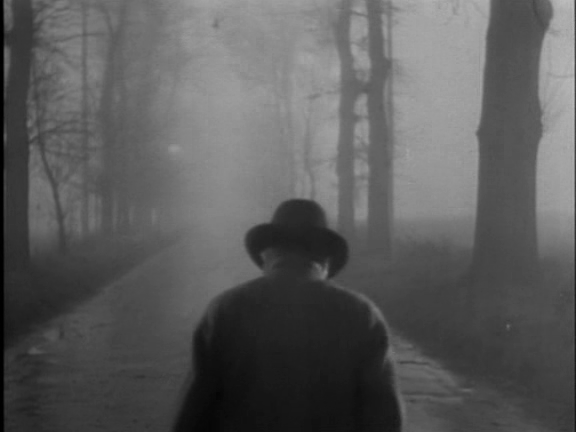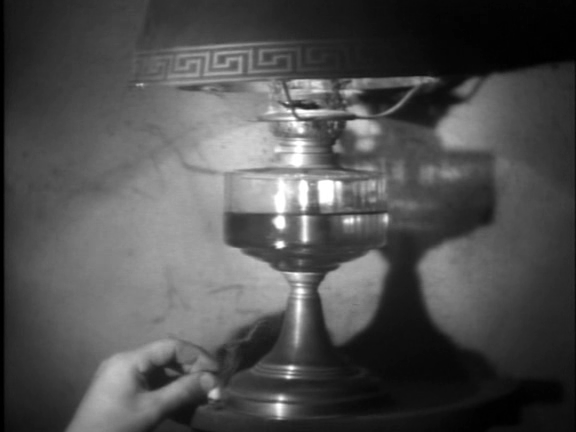
When Maigret met Magritte.
I'm not, in seems, the first to compare Jean Renoir's La nuit du carrefour (The Night at the Crossroads) to Carl Dreyer's Vampyr. It's an odd congruence—Renoir's film is a policier based on one of Georges Simenon's popular Maigret novels, and Dreyer's is a supernatural thriller based on a vampire yarn by the Irish writer Sheridan Le Fanu—which perhaps needs a little unpacking.
The first sense of a resemblance starts early, in the odd way in which the movie moves. This was the thirties, another country far more distant than France, and they do things differently there. The rhythms are different, the camera placement is eccentric, the movement of the camera has a cumbersome quality. While Dreyer's camera has a somnambular drift of its own, Renoir's does move with a greater sense of narrative emphasis...but what he chooses to emphasize in this story often seems quite eccentric. And by his staccato editing, directly zapping from scene to scene, sometimes interrupting scenes with glimpses of mysterious activities elsewhere, he also seems very modern.
The second evocation of Dreyer is odder. A Jewish diamond merchant has been found murdered, and Maigret (played by Renoir's brother Pierre) interrogates the obvious suspect, a Danish aviator shot down during World War One. The fact that this character's bio fits that of Dreyer with strange precision is hard to account for—the film is seemingly very faithful to Simenon's book (one I haven't read)...Georges Koudria plays the character with an exhausted zombie air, one missing eye concealed behind an eyeglass which looks like a film director's blue lens.
Thirdly, the film has in common with Vampyr a feeling that much of the action is taking place elsewhere, while we're not around. The mystery story of course depends on this sensation to conceal vital plot information, and Renoir's interest in creating a messy sense of real life in his films often led him to experiment with ways of keeping action from us—The Rules of the Game is, among so many other things, a compendium of techniques for implying situations so busy with important activity that it's impossible to catch everything at once. Vampyr's plot mostly happens offscreen, leaving its hapless hero chasing shadows and picking up clues, and the resourceful Maigret is reduced to a similarly baffled state by the rapid pile-up of inexplicable incidents.

"I tried to give you the feeling of mud sticking to your feet, and of fog obscuring your sight." —Renoir.
"We are frightened by this strange and poetic film." —Jean-Luc Godard.
Courage, Jean-Luc, let's see if we can get through this together.
"Boldly composed shots seem veiled, clogged, muffled by the obscure osmosis of mist and night, of headlamps blurrily staring through rain, of strained-for sounds beyond a wall...Renoir works over the limit of focus, and the resultant softness and the black foreground silhouettes recall coagulations of tenebrous air...The film smells of wet earth, of oiled metal, of woodsmoke and manure, of the sulky stove which Maigret has to coax." Raymond Durgnat nails the film's murky feel perfectly here, and the way it manages to be dreamlike while staying specific about garages, awful suburbs, fields. Hitchcock argued that dreams are sharply focussed and terrifyingly clear: Renoir rediscovers the power of confusion and haze by including sharply delineated moments and objects which pierce the miasma of uncertainty like bullets.
"In the matter of mystery the result exceeded our expectations, particularly since, two reels having been lost, the story was pretty well incomprehensible, even to its author...La Nuit de Carrefour remains a completely absurd experiment that I cannot think of without nostalgia." Renoir himself hints at the film's difficult production (it was an independently funded job under Renoir's own supervision), although on other occasions he affected uncertainty as to whether any footage was really lost. Simenon himself, who followed the filming quite closely, once suggested that Renoir was drinking heavily due to marital troubles, and perhaps the film lost cohesiveness due to a certain mental wobbliness on the director's part: a tempting hypothesis, since the misty, shellshocked air of bafflement does somewhat anticipate Peckinpah's Cross of Iron, which Bloody Sam seems to have directed from within a vast tank of Slivovitz, surfacing between gulps to bellow conflicting instructions. Yet the sense of control doesn't quite evaporate amid Carrefour's dank fug: the filmmaker seems to be deliberately pushing us away from clear and purposeful narrative, which suggests a keen awareness of what clear and purposeful narrative is.

Apart from its spring rhythms and occluded visuals, the movie creates a feeling of blindly running a maze by throwing surprises in our path. The doctor who shows up in the third act, dressed for the opera and sporting a Fu Manchu mustache, is one, but the greatest of all is the leading lady, the erotic, strange and very modern Winna Winifried. A shot of her playing with an incongruous pet turtle doesn't discombobulate as much as it should, precisely because her very presence is enough to bend the film's genre all out of whack. Maybe it's because she's a teenager and a foreigner, she explodes the performance style of the film with every gesture, every twist of her long, curvy torso, every seemingly uncontrolled shift of expression on her beautiful yet realistic face.
As Maigret, Pierre Renoir meanwhile aces it by simply getting out of bed and refusing to perform: this is probably the most low-key and therefore best Maigret on film. That same year, Julien Duvivier produced a striking and highly effective take on Simenon's world, entitled La tete d'un homme, with the great Harry Baur as the detective. Baur is great, and holds back for 90% of the movie, but he was incontestably a giant, physically and dramatically, a King Player, and he can't disappear into the raincoat the way Renoir does. (The same novel was later filmed as The Man on the Eiffel Tower, with Charles Laughton showy and inapposite as the inspector—but he directed a few scenes without credit, including a pursuit through a deserted villa with doors swinging shut, glimpsed just as we enter a room, again catching that sense of offscreen activity, just-out-of-reach answers, that may be the most evocatively cinematic element of detective story narration.)

Mystery. Uncertainty. The wall between us and what we can't know. Why did Simenon wire up his Swiss mansion so that he could listen to what was happening in each room when he was elsewhere?
***
The Forgotten is a regular Thursday column by David Cairns, author of Shadowplay.